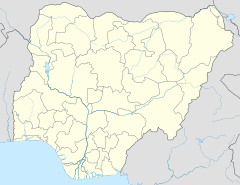Gashaka Gumti National Park
| Gashaka Gumti National Park | ||
|---|---|---|
|
|
||
| Location: | Nigeria | |
| Specialty: | Region Taraba and Adamawa | |
| Next city: | Yola , Gashaka | |
| Surface: | 6670 km² | |
| Founding: | 1991 | |
The Gashaka Gumti National Park is the largest National Park in Nigeria . It is located in the eastern provinces of Taraba and Adamawa on the border with Cameroon and covers an area of 6670 km². The national park was established in 1991 by amalgamating the Gashaka and Gumti wildlife reserves .
geography
The northern area around the village of Gumti is relatively flat terrain and is located on the Mambilla plateau , about 430 meters above sea level. It is occupied by large forest areas and grass savannahs, which correspond to the vegetation type of the Western Sudan savannah . The southern area, around the village of Gashaka, is characterized by very mountainous, steep mountain slopes and deeply cut valleys and gorges. In it lies the highest mountain in Nigeria, the 2,416 meter high Chappal Waddi . The vegetation of this sector is determined by large rainforest areas , which are interspersed with mountain grass savannahs. In this mountainous terrain there are many small lakes that are fed by streams and smaller rivers , the largest of which is the Taraba . The national park is located in the catchment area of the Benue , the largest river in eastern Nigeria and the largest tributary of the Niger .
flora
The tree population of the Western Sudan savannah is dominated by the tree species Daniellia oliveri , Lophira lanceolata , Afzelia africana , Isoberlinia doka and Burkea africana . In flat areas of the northern sector, the lowland forests are dominated by the Limba tree ( Terminalia superba ), the Khaya grandifoliola and the Iriko ( Milicia excelsa ). In the mountainous southern sector, the rainforests are dominated by the Syzygium guineense , Prunus africana and Ilex mitis . The species Loudetia simplex and Andropogon are also found in the mountain grass savannahs .
fauna
The fauna of the national park is very diverse. 103 species of mammals were recorded in censuses. The largest population in Nigeria of chimpanzees ( Pan troglodytes ) is found within the boundaries of the national park. The Gashaka Primate Project was set up to protect them. Furthermore, the African elephant ( Loxodonta africana ), the African wild dog ( Lycaon pictus ), the giant eland ( Taurotragus derbianus ), the horse antelope ( Hippotragus equinus ) and the mountain ridgeo ( Redunca fulvorufula ) live in large numbers in the national park .
Avifauna
The avifauna is very rich, so the populations are estimated at up to 1 million birds . The number of bird species recorded so far in censuses is around 366. It is estimated that 300 to 500 species of butterflies are suspected within the park boundaries.
